"A little more meat on the ribs doesn't hurt with perreo," says Nicole Olmeda, explaining which movements make up the physical dance that is part of reggaeton. The music genre is ubiquitous here in Puerto Rico's capital, San Juan, on the streets, in the cafes and clubs, a rousing genre of reggae, hip-hop, Latin American, Caribbean and electronic music.
According to Nicole Olmeda, the beat is crucial. Anyone who hears and feels it - and it's not that easy, she admits - surrenders to a state that, for the Puerto Rican, can be summed up in three words: joy, fun and freedom.
It is this attitude towards life that Nicole Olmeda wants to share with visitors. The employee of the tourism organization Discover Puerto Rico is a real Boricua, as the locals from the language of the Taíno indigenous people call themselves. Her eyes sparkle as she talks about her homeland, the “rich haven,” as Puerto Rico translates. On a boat tour to the offshore island of Culebra, the Caribbean Sea, the national drink Piña Colada and the sun provide good arguments for their enthusiasm.
But for Nicole Olmeda it is above all the music that reflects the character of Puerto Rico. While her parents still danced and sang to salsa, reggaeton is the musical expression of the younger generation. And for the young Boricua, it has its origin right here, in the middle of Old San Juan. Where Daddy Yankee, icon and driving force of this genre, began his local and international career.
Visitors can learn more on a tour with music expert Clement de Freitas. He knows the streets of the old town like his record collection, his stories are an entertaining mixture of nostalgia, passion and impressive knowledge.
The 50-year-old, who belongs to the Salsa generation, explains the birth of reggaeton as follows: The music was created in the mid-20th century with influences from all over the Caribbean, Latin America and even Africa. Because without these countries, the variety of salsa music that became popular in the 50s, 60s and 70s would not have existed: merengue from the Dominican Republic, mambo from Cuba, bossa nova from Brazil and bomba, a music genre created by African slaves on Puerto Rico's plantations 400 years ago. Genres that shaped the following styles and thus also reggaeton.
In order to understand the exciting culture of the Caribbean island state, it is worth taking a look at its history. Now a U.S. territory, it was inhabited by Taínos more than 1,000 years before Christopher Columbus arrived in 1493. African slaves came to the country with the Spaniards, as well as armed conflicts with the French, English and Dutch.
The centuries-old fortresses, including the Castillo San Felipe del Morro and the Castillo San Cristobal, are well-preserved witnesses of this era. The Caribbean island was declared US territory in 1898, and Puerto Ricans have been US citizens since 1917.
And De Freitas brings into play another main location that directly influenced reggaeton: New York. In the 1970s and 1980s, the Bronx in particular was marked by the lack of prospects for its predominantly Afro-American residents.
Decades before Jennifer Lopez sang about her Puerto Rican and Bronx roots in her songs, Puerto Ricans were migrating to East Harlem and the South Bronx following the first wave of immigrants bound for Spanish Harlem. Then as now, the largest Puerto Rican community lives outside of their home country.
In the Bronx in particular, the islanders came into contact with rap and hip-hop. Genres that lived from their explicit lyrics about racism, drugs, violence, sex and educational deficits - they took this music with them when they next visited their family. In Puerto Rico, rap became Latin rap, ie rap in their native Spanish language.
At the same time, but on a different flight path, a second musical element came into play that makes reggaeton unmistakable and, according to Nicole Olmeda, is crucial: the beat. Its origin is around 1100 kilometers west of Puerto Rico, in Jamaica. Born in the 1960s, reggae is an invitation to slow, laid-back life on the beach. How did this almost meditative sound get to the intense beat of reggaeton?
Here, too, it was quite simply the living conditions of a new generation that knew how to communicate critically through music. The slow reggae groove gave way to a beat-heavy version known as dancehall music. The electronic “dance hall” rhythms are hard, and the energy that accumulates as a result is discharged through movement. But not only beat and dance came to Puerto Rico from Jamaica, part of the name was also adopted for the new local music style.
"There are two explanations for the origin of the term reggaeton," says Clement de Freitas. "It's a combination of reggae and 'tón' – 'tón' means something big in Puerto Rico." The other is a combination of the words reggae and maratón (marathon) by DJ Nelson, who was largely responsible for the development of reggaeton was.
Similar to other musical genres, reggaeton in Puerto Rico first emerged outside the middle class. Especially in the "Projects", residential areas outside of Old San Juan, where poverty, unemployment, crime and violence were visible on the streets - and were addressed by musicians. But with these lyrics, in contrast to the rousing beat, it was not possible to earn big money in the music industry.
DJ Negro was one who recognized this quickly and was willing to go the commercial route without the rap accompaniment for the time being. During his music tours, Clement de Freitas takes participants to Calle de la Tanca, among other places. Here, in the middle of Old San Juan, Felix Rodriguez aka DJ Negro created a home for reggaeton in the 1990s in a colonial-style building with the former club "The Noise". And debuted then-teen Daddy Yankee, who brought singing back to the beats, to perform to large audiences for the first time.
For any Puerto Rican, the rest is history, because with over 180 awards and almost 490 nominations, Daddy Yankee is one of the most successful stars in the genre. Even beyond the island borders. The single "Despacito," a 2017 collaboration with Latin pop singer Luis Fonsi and Canadian star Justin Bieber, became the first Spanish-language song to reach number one after "La Bamba" (1987) and "Macarena" (1996). the Billboard Hot 100.
The accompanying video was shot in the historic district of La Perla and in the popular music bar "La Factoría" in Old San Juan. “La Factoría” is actually a collection of five bars with different floors for dancing, and the cocktails are also legendary.
Daddy Yankee is "one of them," says Nicole Olmeda. You can see him not only on TV, but also in the restaurants and on the beautiful beaches of the island. And now he has more time for it than ever, because in March of this year the star announced his farewell after 32 years with a final tour and his eighth album "Legendaddy".
Exactly why is speculated. But Clement de Freitas is certain: “Reggaeton is the mouthpiece of the younger generation. At some point even Daddy Yankee grows out of the issues that move the young fans. He makes room for his successors, who describe life in the neighborhoods.” Including female rap singers like Ivy Queen.
One of the biggest newcomers to the scene is San Juan-born Benito Antonio Martínez Ocasio, aka Bad Bunny. With 44.3 million followers on Instagram, currently just 15 posts and exactly zero Instagram accounts that he doesn't follow, he raps about normal everyday life, but his posters are already hanging along the highways.
Reggaeton can be heard everywhere in the streets. Nicole Olmeda counts the cars from which the sound is booming - here, in Santurce, a district of San Juan that is considered a hotspot for local street art. There is also a tour on this subject that should not be missed.
After the city tour in the footsteps of the music of Puerto Rico, one understood: reggaeton is not just music. It's a lifestyle that, just like rap, hip-hop and dancehall, is expressed through fashion, jewelry and the right attitude. And the music will certainly not only inspire fans in Puerto Rico in the future, but all over the world.
getting there
From Munich, Frankfurt and Berlin, for example, via New York to San Juan, Puerto Rico with United Airlines (https://united.com). Or with American Airlines (https://www.americanairlines.de/) from Frankfurt via Dallas to San Juan, Puerto Rico. For entry into Puerto Rico, the usual guidelines apply as in the USA.
accomodation
In the heart of Old San Juan: boutique hotel "Casablanca" with roof terrace, double rooms from 180 euros (hotelcasablancapr.com). Just a few minutes' walk from the beach and around 20 minutes' drive from Old San Juan: "Verdanza Hotel" in the Isla Verde district, double rooms from 170 euros (verdanzahotel.com).
guides
Music tours with Clement de Freitas, as a group or private, the guided tour "La Ruta de la Salsa" costs from 50 euros per person, bookable through CL Tours PR (cltourspr.com).
Street art tours with Georgie Vega, the guided tour "La Calle Cerra Street Art Tour" through the Santurce district costs from 80 euros per person, bookable through The Art Walk PR (theartwalkpr.com).
information
Discover Puerto Rico, discoverpuertorico.com

 Iran-Israel conflict: what we know about the events of the night after the explosions in Isfahan
Iran-Israel conflict: what we know about the events of the night after the explosions in Isfahan Sydney: Assyrian bishop stabbed, conservative TikToker outspoken on Islam
Sydney: Assyrian bishop stabbed, conservative TikToker outspoken on Islam Torrential rains in Dubai: “The event is so intense that we cannot find analogues in our databases”
Torrential rains in Dubai: “The event is so intense that we cannot find analogues in our databases” Rishi Sunak wants a tobacco-free UK
Rishi Sunak wants a tobacco-free UK Alert on the return of whooping cough, a dangerous respiratory infection for babies
Alert on the return of whooping cough, a dangerous respiratory infection for babies Can relaxation, sophrology and meditation help with insomnia?
Can relaxation, sophrology and meditation help with insomnia? WHO concerned about spread of H5N1 avian flu to new species, including humans
WHO concerned about spread of H5N1 avian flu to new species, including humans New generation mosquito nets prove much more effective against malaria
New generation mosquito nets prove much more effective against malaria The A13 motorway closed in both directions for an “indefinite period” between Paris and Normandy
The A13 motorway closed in both directions for an “indefinite period” between Paris and Normandy The commitment to reduce taxes of 2 billion euros for households “will be kept”, assures Gabriel Attal
The commitment to reduce taxes of 2 billion euros for households “will be kept”, assures Gabriel Attal Unemployment insurance: Gabriel Attal leans more towards a tightening of affiliation conditions
Unemployment insurance: Gabriel Attal leans more towards a tightening of affiliation conditions “Shrinkflation”: soon posters on shelves to alert consumers
“Shrinkflation”: soon posters on shelves to alert consumers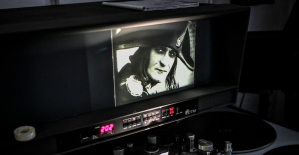 The restored first part of Abel Gance's Napoléon presented at Cannes Classics
The restored first part of Abel Gance's Napoléon presented at Cannes Classics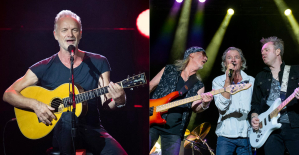 Sting and Deep Purple once again on the bill at the next Montreux Jazz Festival
Sting and Deep Purple once again on the bill at the next Montreux Jazz Festival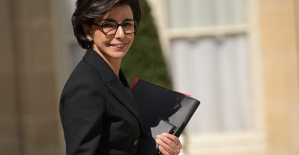 Rachida Dati: one hundred days of Culture on the credo of anti-elitism
Rachida Dati: one hundred days of Culture on the credo of anti-elitism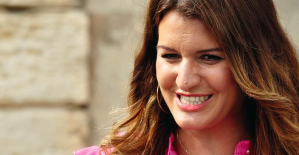 The unbearable wait for Marlène Schiappa’s next masterpiece
The unbearable wait for Marlène Schiappa’s next masterpiece Skoda Kodiaq 2024: a 'beast' plug-in hybrid SUV
Skoda Kodiaq 2024: a 'beast' plug-in hybrid SUV Tesla launches a new Model Y with 600 km of autonomy at a "more accessible price"
Tesla launches a new Model Y with 600 km of autonomy at a "more accessible price" The 10 best-selling cars in March 2024 in Spain: sales fall due to Easter
The 10 best-selling cars in March 2024 in Spain: sales fall due to Easter A private jet company buys more than 100 flying cars
A private jet company buys more than 100 flying cars This is how housing prices have changed in Spain in the last decade
This is how housing prices have changed in Spain in the last decade The home mortgage firm drops 10% in January and interest soars to 3.46%
The home mortgage firm drops 10% in January and interest soars to 3.46% The jewel of the Rocío de Nagüeles urbanization: a dream villa in Marbella
The jewel of the Rocío de Nagüeles urbanization: a dream villa in Marbella Rental prices grow by 7.3% in February: where does it go up and where does it go down?
Rental prices grow by 7.3% in February: where does it go up and where does it go down? With the promise of a “real burst of authority”, Gabriel Attal provokes the ire of the opposition
With the promise of a “real burst of authority”, Gabriel Attal provokes the ire of the opposition Europeans: the schedule of debates to follow between now and June 9
Europeans: the schedule of debates to follow between now and June 9 Europeans: “In France, there is a left and there is a right,” assures Bellamy
Europeans: “In France, there is a left and there is a right,” assures Bellamy During the night of the economy, the right points out the budgetary flaws of the macronie
During the night of the economy, the right points out the budgetary flaws of the macronie These French cities that will boycott the World Cup in Qatar
These French cities that will boycott the World Cup in Qatar Champions League: France out of the race for 5th qualifying place
Champions League: France out of the race for 5th qualifying place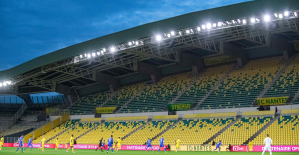 Ligue 1: at what time and on which channel to watch Nantes-Rennes?
Ligue 1: at what time and on which channel to watch Nantes-Rennes? Marseille-Benfica: 2.99 million viewers watching OM’s victory on M6
Marseille-Benfica: 2.99 million viewers watching OM’s victory on M6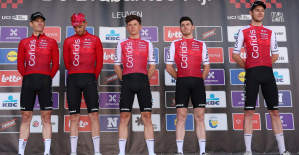 Cycling: Cofidis continues its professional adventure until 2028
Cycling: Cofidis continues its professional adventure until 2028


















